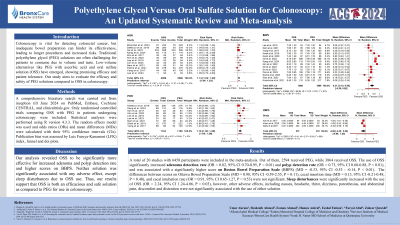Monday Poster Session
Category: General Endoscopy
P2404 - Polyethylene Glycol Versus Oral Sulfate Solution for Colonoscopy: An Updated Systematic Review and Meta-Analysis
Monday, October 28, 2024
10:30 AM - 4:00 PM ET
Location: Exhibit Hall E

Has Audio

Faryal Altaf, MD
BronxCare Health System
Bronx, NY
Presenting Author(s)
Umar Akram, 1, Shahzaib Ahmed, MBBS2, Eeman Ahmad, MBBS2, Hamza Ashraf, MBBS1, Eeshal Fatima, MBBS3, Faryal Altaf, MD4, Zaheer Qureshi, MD5
1Allama Iqbal Medical College, Lahore, Punjab, Pakistan; 2Fatima Memorial Hospital College of Medicine and Dentistry, Lahore, Punjab, Pakistan; 3Services Institute of Medical Sciences, Lahore, Punjab, Pakistan; 4BronxCare Health System, Bronx, NY; 5The Frank H. Netter M.D. School of Medicine at Quinnipiac University, Bronx, NY
Introduction: Colonoscopy is vital for detecting colorectal cancer, but inadequate bowel preparation can hinder its effectiveness, leading to longer procedures and increased risks. Traditional polyethylene glycol (PEG) solutions are often challenging for patients to consume due to volume and taste. Low-volume alternatives like PEG with ascorbic acid and oral sulfate solution (OSS) have emerged, showing promising efficacy and patient tolerance. Our study aims to evaluate the efficacy and safety of PEG solutions compared to OSS in colonoscopy.
Methods: A comprehensive literature search was carried out from inception till June 2024 on PubMed, Embase, Cochrane CENTRAL, and clinicaltrials.gov. Only randomised controlled trials comparing OSS with PEG in patients undergoing colonoscopy were included. Statistical analyses were performed using R version 4.3.3. The random effects model was used and odds ratios (ORs) and mean differences (MDs) were calculated with their 95% confidence intervals (CIs). Publication bias was assessed by Luis Furuya-Kanamori (LFK) index, funnel and doi plots.
Results: A total of 20 studies with 6458 participants were included in the meta-analysis. Out of them, 2594 received PEG, while 3864 received OSS. The use of OSS significantly increased adenoma detection rate (OR = 0.82, 95% CI 0.70-0.95, P = 0.01) and polyp detection rate (OR = 0.73, 95% CI 0.60-0.88, P < 0.01), and was associated with a significantly higher score on Boston Bowel Preparation Scale (BBPS) (MD = -0.33, 95% CI -0.53 - -0.14, P < 0.01). The differences between scores on Ottawa Bowel Preparation Scale (MD = 0.98, 95% CI -0.59-2.55, P = 0.11), cecal insertion time (MD = 0.13, 95% CI -0.21-0.48, P = 0.40), and cecal intubation rate (OR = 0.91, 95% CI 0.65-1.27, P = 0.53) were not significant. Sleep disturbances were significantly increased with the use of OSS (OR = 2.24, 95% CI 1.24-4.06, P = 0.03), however, other adverse effects, including nausea, headache, thirst, dizziness, paresthesias, and abdominal pain, discomfort and distention were not significantly associated with the use of either solution.
Discussion: Our analysis revealed OSS to be significantly more effective for increased adenoma and polyp detection rate and higher scores on BBPS. Neither solution was significantly associated with any adverse effect, except sleep disturbances due to OSS use. Thus, our results support that OSS is both an efficacious and safe solution as compared to PEG for use in colonoscopy.
Note: The table for this abstract can be viewed in the ePoster Gallery section of the ACG 2024 ePoster Site or in The American Journal of Gastroenterology's abstract supplement issue, both of which will be available starting October 27, 2024.
Disclosures:
Umar Akram, 1, Shahzaib Ahmed, MBBS2, Eeman Ahmad, MBBS2, Hamza Ashraf, MBBS1, Eeshal Fatima, MBBS3, Faryal Altaf, MD4, Zaheer Qureshi, MD5. P2404 - Polyethylene Glycol Versus Oral Sulfate Solution for Colonoscopy: An Updated Systematic Review and Meta-Analysis, ACG 2024 Annual Scientific Meeting Abstracts. Philadelphia, PA: American College of Gastroenterology.
1Allama Iqbal Medical College, Lahore, Punjab, Pakistan; 2Fatima Memorial Hospital College of Medicine and Dentistry, Lahore, Punjab, Pakistan; 3Services Institute of Medical Sciences, Lahore, Punjab, Pakistan; 4BronxCare Health System, Bronx, NY; 5The Frank H. Netter M.D. School of Medicine at Quinnipiac University, Bronx, NY
Introduction: Colonoscopy is vital for detecting colorectal cancer, but inadequate bowel preparation can hinder its effectiveness, leading to longer procedures and increased risks. Traditional polyethylene glycol (PEG) solutions are often challenging for patients to consume due to volume and taste. Low-volume alternatives like PEG with ascorbic acid and oral sulfate solution (OSS) have emerged, showing promising efficacy and patient tolerance. Our study aims to evaluate the efficacy and safety of PEG solutions compared to OSS in colonoscopy.
Methods: A comprehensive literature search was carried out from inception till June 2024 on PubMed, Embase, Cochrane CENTRAL, and clinicaltrials.gov. Only randomised controlled trials comparing OSS with PEG in patients undergoing colonoscopy were included. Statistical analyses were performed using R version 4.3.3. The random effects model was used and odds ratios (ORs) and mean differences (MDs) were calculated with their 95% confidence intervals (CIs). Publication bias was assessed by Luis Furuya-Kanamori (LFK) index, funnel and doi plots.
Results: A total of 20 studies with 6458 participants were included in the meta-analysis. Out of them, 2594 received PEG, while 3864 received OSS. The use of OSS significantly increased adenoma detection rate (OR = 0.82, 95% CI 0.70-0.95, P = 0.01) and polyp detection rate (OR = 0.73, 95% CI 0.60-0.88, P < 0.01), and was associated with a significantly higher score on Boston Bowel Preparation Scale (BBPS) (MD = -0.33, 95% CI -0.53 - -0.14, P < 0.01). The differences between scores on Ottawa Bowel Preparation Scale (MD = 0.98, 95% CI -0.59-2.55, P = 0.11), cecal insertion time (MD = 0.13, 95% CI -0.21-0.48, P = 0.40), and cecal intubation rate (OR = 0.91, 95% CI 0.65-1.27, P = 0.53) were not significant. Sleep disturbances were significantly increased with the use of OSS (OR = 2.24, 95% CI 1.24-4.06, P = 0.03), however, other adverse effects, including nausea, headache, thirst, dizziness, paresthesias, and abdominal pain, discomfort and distention were not significantly associated with the use of either solution.
Discussion: Our analysis revealed OSS to be significantly more effective for increased adenoma and polyp detection rate and higher scores on BBPS. Neither solution was significantly associated with any adverse effect, except sleep disturbances due to OSS use. Thus, our results support that OSS is both an efficacious and safe solution as compared to PEG for use in colonoscopy.
Note: The table for this abstract can be viewed in the ePoster Gallery section of the ACG 2024 ePoster Site or in The American Journal of Gastroenterology's abstract supplement issue, both of which will be available starting October 27, 2024.
Disclosures:
Umar Akram indicated no relevant financial relationships.
Shahzaib Ahmed indicated no relevant financial relationships.
Eeman Ahmad indicated no relevant financial relationships.
Hamza Ashraf indicated no relevant financial relationships.
Eeshal Fatima indicated no relevant financial relationships.
Faryal Altaf indicated no relevant financial relationships.
Zaheer Qureshi indicated no relevant financial relationships.
Umar Akram, 1, Shahzaib Ahmed, MBBS2, Eeman Ahmad, MBBS2, Hamza Ashraf, MBBS1, Eeshal Fatima, MBBS3, Faryal Altaf, MD4, Zaheer Qureshi, MD5. P2404 - Polyethylene Glycol Versus Oral Sulfate Solution for Colonoscopy: An Updated Systematic Review and Meta-Analysis, ACG 2024 Annual Scientific Meeting Abstracts. Philadelphia, PA: American College of Gastroenterology.
